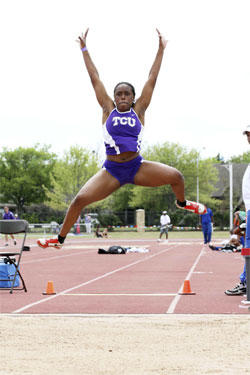His eyes are fixed on the sandpit 15-meters ahead of him. He takes a deep breath.
“And one… and two… and three.”
He silently counts his strides as he approaches the board.
Takeoff.
Junior Jonathan Jackson and freshman Neidra Covington are the two jumpers for TCU that are making leaps and bounds in the NCAA qualifying meets this season.
Personalities aside, these two jumpers are scoring points in meets for the Flying Frogs while showcasing their prowess in an event dominated by finesse and technique rather than brute strength and athleticism.
From the eyes of the audience, the jumpers seem to be taking a handful of strides, jumping and then rolling in the sandpit. At a closer view, there is a science to being airborne from the final stride touching the board to landing the jump in the fine grains of the pit.
“There are three main forms in long jump,” jumpers’ coach Jeff Petersmeyer said. “The sail, the hitch-kick and the hang.”
Each method has its respective uses depending on the jumper, and it is as much an act of physics as it is acrobatics.
THE TAKEOFF
Before the techniques are put into full effect in the air, the jumpers have to master the strides it takes to reach the platform.
Covington counts out eight strides with focus on the first three steps having the most force.
“I make sure my first three strides are strong,” Covington said.
The stride count is one of the more important adjustments made in the approach to the board in order to center both the runners’ focus and timing.
“I count all eight strides,” Covington said. “Each time my right foot hits, I count one.”
Jackson has a similar method while prepping for his jump. He starts with his jump leg – the one he pushes off with when he reaches the board – out in front and then from his first step, he starts a cadence.
“And…”
Then his jump foot touches down.
“One…”
The process continues following a methodical pace as he counts under his breath until he reaches the platform and begins to fly towards another NCAA qualifying mark.
THE SAIL
The sail method is a more archaic form of long jumping, Petersmeyer said, many modern jumpers do not bother with the technique.
Sailing is a rather unorthodox form and has been outdone by both the hang and hitch-kick methods.
THE HITCH-KICK
Hitch-kicking made national headlines when Carl Lewis performed this technique perfectly in his final Olympic Games in Atlanta in 1996.
“I remember watching Carl Lewis in 1996 from the sixth row of the stadium,” Petersmeyer said.
Lewis won the event for the fourth consecutive time that year as he flew through the air and into Olympic lore.
More than a decade has passed since Lewis’ jumps were in the record books, and Petersmeyer is now helping coach the Flying Frogs.
“It is the most successful if the jumper is good enough to hitch-kick,” Petersmeyer said.
Both his jumpers have tried the style, but neither have taken a liking to the method.
“You look at the personnel you have the type of jumper they are,” Petersmeyer said. “As a coach you have to adapt to your clientele.”
THE HANG
His two horizontal jumpers, Jackson and Covington, have taken a liking to the hang style of long jump.
The hang is an act of physics for the jumper once he or she is airborne.
“The key is to deter forward rotation by extending the body in a ‘C’ position,” Petersmeyer said.
Covington is attending TCU on a full scholarship while chipping away at personal and school records in the long jump, but she said there are parts of her approach that still need practice.
“I am still trying to work on the degree of my body when I hit the board (for takeoff),” Covington said.
The technique has brought Covington regular improvement through the season, though she has not bested her personal record in the long jump yet.
“Sometimes you have a new jumper and a new coach and it takes some time to get adjusted,” Petersmeyer said.
THE LANDING
Long jump rules and regulations have been static over time and the landing is a point in the jump in which a contestant can lose valuable inches on the measurement. If a jumper falls backward after landing in the pit, the measurement will be taken from the point furthest back, not forward.
In order to prevent a backward tumble, Petersmeyer coaches his jumpers on letting momentum take its toll during the landing. He did mention, however, that other jumpers throughout history have had some different techniques of “sticking the landing.”
“Jessie Owens would land and then pop up and move forward,” Petersmeyer said.
The step-by-step landing that Petersmeyer tries to teach involves pulling the butt to the heels once in the sand and then using the hands to roll to the side when the momentum is done carrying the jumper.
Jackson said his landing is based entirely on his momentum just carrying him through the pit while trying to just glide through a landing on his butt or heels.
When going into the final approach, Covington follows a similar approach.
“I try to land on my butt and scoot letting my force bring me forward,” Covington said.
THE FINAL PRODUCT
For a brief second in the air, the long jumper is in flight making a glorious arc toward the sands below.
While suspended above the pit, the jumpers are calculating and adjusting for the landing that befalls them. For the Flying Frogs, the two jumpers, Covington and Jackson, every stride to the platform is another chance to engrave their names in the TCU record books.





